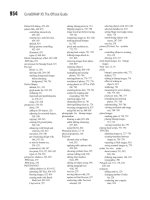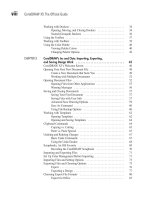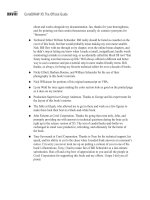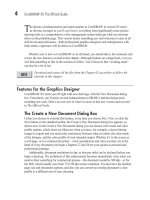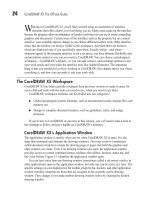CorelDRAW X5 The Official Guide part 37 pdf
Bạn đang xem bản rút gọn của tài liệu. Xem và tải ngay bản đầy đủ của tài liệu tại đây (455.31 KB, 10 trang )
●
Dryout This option sets a rate for the effect of gradually reducing the width of a
smudge according to the speed of your click-drag action and can be set between –10
and 10. Higher values cause your smudge to be reduced in width more quickly (as
shown next), while a setting of 0 deactivates the Dryout effect. Interestingly,
negative Dryout values make your stroke begin small and eventually widen as you
click-drag.
●
Tilt The Tilt value controls the elliptical shape of the Smudge tool nib. Tilt is
measured in degrees set between 15º (a flat-shaped nib) and 90º (a circular-shaped
nib), as shown next. Tilt and Bearing values (discussed next) work in combination
with each other to control the smudge nib shape.
324 CorelDRAW X5 The Official Guide
Dryout setting of 3
Dryout setting of 10
Dryout setting of –8
Tilt = 15º,
Bearing = 0º
Tilt = 45º,
Bearing = 0º
Tilt = 90º,
Bearing = 0º
●
Bearing Bearing lets you set the angle of the cursor in circular degrees (0 to 359º).
The effects of changing Bearing are most noticeable at lower Tilt values—such as
15°, as shown here. It’s the rotational angle of a non-circular tip.
Using the Free Transform Tool
The Free Transform tool, located in the same group as the Smudge brush, the Shape tool,
and the Roughen brush, is your one-stop shop for performing rotations, skews, and other
object transformations using an onscreen guide.
Unlike with the Pick tool for object transformations, the Free Transform tool has a handle
by which you steer and have precise control over the object you manipulate. To use the tool,
you choose it from the toolbox, choose a transformation type on the property bar, and then
with the object selected, you click-drag on a control point (or any object node) to set the center
of the transformation; dragging reveals a handle that also serves as a visual indicator of the
amount of transformation you’re creating. This preview of the transformation is in effect until
you release the mouse button. As you can see in this illustration, it’s obvious the rectangle is
CHAPTER 11: Editing Objects 325
11
Tilt = 15°,
Bearing = 30°
Tilt = 15°,
Bearing = 45°
Tilt = 15°,
Bearing = 90°
Free Transform tool
Property bar options
Rotate
Reflect Scale
Skew
being rotated, where the center of rotation is, and the extent of the rotation before the
transformation is actually made.
The Roughen Brush
To add a touch of character and imperfection to ultra-precise objects, you have the new
Roughen brush in the group with the Smudge brush, shown here:
The Roughen brush alters the course of an outline path on an object, and depending on
the setting you use on the property bar, you can achieve effects that range from lightning
bolts, to really gnarly lines, to zigzag patterns, just by dragging on the edge of a shape. The
options you have when using the Roughen brush can be seen here on the property bar;
they’re similar to those of the Smudge brush:
326 CorelDRAW X5 The Official Guide
Brush Diameter
Frequency Dryout Tilt
Pen Bearing
Spike Direction
(digitizing stylus only)
●
Brush Diameter This sets the size of the Roughen brush. It’s usually a good idea
to scale the nib in proportion to the selected object you want to roughen. By default
the scale of the nib is measured in inches.
●
Pressure Sensitivity If you use a digitizing tablet and stylus that responds to
pressure, this option can be used to vary the nib width as you drag over object areas.
The option is dimmed on the property bar if CorelDRAW doesn’t detect a digitizing
tablet hooked up to your system.
●
Frequency You’ll see that the Roughen brush creates irregularity on an object
edge that is similar to the peaks and valleys of a mountain range—it varies the object
outline in an “in and out” fashion. At low Frequency values, the roughened object
outline will feature large, varying areas. At high Frequency settings, you’ll attain a
zigzag effect. The range of Frequency is from 1 to 10 (10 produces zigzags).
●
Dryout Like the Smudge brush, the Roughen brush can “dry out” at the end of a
stroke you drag with the cursor. The range of dryout effect is from –10 (the stroke
tapers in the opposite direction in which you click-drag) to 10 (the stroke tapers and
fades). At 0, the stroke remains consistent. The greater the Dryout setting, negative
or positive, the more natural a roughened appearance you can achieve.
●
Tilt This option measures your stroke with the Roughen brush perpendicular to the
edge on which you stroke. Therefore, if you have an edge that travels straight up and
down, at a 90° setting you’ll achieve very little effect. In your experiments with this
tool, try 45°, an overall good setting for all angles of edges on most objects. When
you roughen an edge that already has roughening applied, you overwrite the
previous distortion of that edge. Figure 11-11 shows two examples of the Roughen
brush; at left a small nib is used at a low Frequency, and at right a large nib is used at
high Frequency.
Shapes that have special properties, such as rectangles and ellipses created with the
Rectangle and Ellipse tools, need to be simplified using the Arrange | Convert To
Curves command (
CTRL+Q) before they can be roughened. If you try to use the
Roughen brush on such a shape, you’ll get an attention box telling you that the
object needs simplifying, but then CorelDRAW will automatically do the operation
for you. So if you want to avoid the attention box, press
CTRL+Q while a shape is
selected, so you can get right down to editing.
This chapter has taken you through several processes by which you can create minor and
big-time alterations to just about anything you draw; additionally, many of the operations
apply to bitmaps you bring into the workspace. Use the command that best suits the task you
have in mind, and use your judgment as to which operation will get you to your goal fastest.
Personal computers are productivity enhancers: there’s no need to labor over something
when CorelDRAW and your PC can do it for you in less time.
CHAPTER 11: Editing Objects 327
11
Now that you have one, or two, or a dozen shapes on your drawing page, it would be
nice to mix them up with some honest-to-gosh text: a headline here, a little body copy there.
Shapes and words live together, practically no one publishes an image-only website, and
Chapter 12, Part IV of this guide gets you into the language of typography and the features
in CorelDRAW that make your keyboard a professional communications tool.
328 CorelDRAW X5 The Official Guide
FIGURE 11-11 Use the Roughen brush to achieve object complexity in a fraction of the time
needed using other tools.
PART IV
Working with Text
This page intentionally left blank
CHAPTER 12
Getting Artistic with Text
331
C
orelDRAW is all about communication and expressing yourself; this chapter and the
others in this part show you how to use text in a CorelDRAW creation to support and
enhance your ideas as expressed on a page. This chapter gets you started with the Text tool
and other CorelDRAW type features and shows you how to present your thoughts and ideas
invitingly and clearly. Text and graphics go hand in hand in presentations; whether it’s a
poster, a newsletter, a banner, or a logo, you have the tools at your disposal. This chapter
shows you how to access and work with them.
Download and extract all the files from the Chapter12.zip archive to follow the
tutorials in this chapter.
CorelDRAW’s Text Tool
All text you want to enter on a page in CorelDRAW is created with the Text tool, the tool
with an A as its icon in CorelDRAW’s toolbox. To begin designing, click its button in the
toolbox, press
F8, or double-click an existing text object. The Text tool cursor is a small
crosshair with an A below and to the right, which becomes an I-beam (a text-editing cursor)
when it’s over a text object.
A shortcut to reselect the Pick tool while the Text tool is selected is
CTRL+SPACEBAR—
for all other tools, you can press either
SPACEBAR or CTRL+SPACEBAR.
When you use the Text tool, you can produce two different types of text objects in a
document: artistic text and paragraph text. Figure 12-1 shows a simple layout that uses
artistic text in combination with the Text | Fit Text To Path command—the path is hidden in
this illustration. The smaller body text uses paragraph text; the top paragraph wraps around
the top of the image by use of a CorelDRAW envelope (see Chapter 20). Artistic text and
paragraph text have different properties, but are added to a document by using the same Text
tool. Artistic text, by the way it’s produced in a document, is easy to reshape and distort—
you’ll find it simple to do artistic things with it, such as creating a company logo. Conversely,
paragraph text is optimized for longer amounts of text, and it’s a great text attribute for
quickly modifying columns of, for example, instructions, recipes, short stories, and so on.
In short, paragraph text is best used for several paragraphs of text in a composition, while
artistic text should be reserved for headlines and just a few lines of text you might want to
curve along a path, extrude, or do something else unique and fancy with.
Although artistic text and paragraph text have some similarities, you’re best off using
one or the other depending on the type of text element you want in your design.
332 CorelDRAW X5 The Official Guide
Text copied from the Clipboard can be pasted when the Pick tool is your current
tool. Usually, unformatted text—text from a TXT file you copied from Textpad, for
example—will import as paragraph text.
●
Text imported without a Text tool insertion point entered on the page comes in as
paragraph text.
●
Text pasted with an insertion point made on the page imports as artistic text.
Text copied from word processors will import as a document object; double-clicking
the object offers in-place editing exactly as you’d edit a WordPerfect or Microsoft
Word document. It’s usually best to choose Edit | Paste Special when pasting
Clipboard text, to ensure that correct formatting and the original fonts are used,
and to use the Text tool’s I-beam cursor to insert pasted text.
CHAPTER 12: Getting Artistic with Text 333
12
FIGURE 12-1 Artistic text and paragraph text have different attributes, and each is suited for
different text treatments in a design.
Artistic text
Paragraph text
